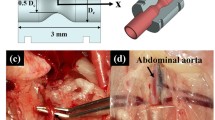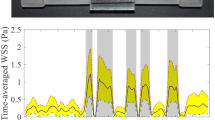Abstract
The stenotic geometry produces spatial and temporal regions such as high and low wall shear stress and flow separation. This disturbed blood flow in stenotic vessel can result in the further progress of atherogenesis. Therefore, the association between blood flow and geometrical factor need to be figured out by understanding the hemodynamic phenomena. The pulsatile flow features through a stenotic tube were investigated based on angiograms using a time-resolved particle image velocimetry (PIV) technique. A model of the tube core with stenosis was fabricated using a 3D printer, and the final tube model was fabricated with PDMS (polydimethylsiloxane). To prevent optical distortion, a mixture with glycerin and de-ionized water was used as the flow medium and a substitute for blood plasma. For PIV measurements, the concentration of fluorescence particles was controlled about 0.01 wt%. The flow rates were controlled using a circulating pump and silicon tubes from 1.6 to 3.7 mL/min. The pulsatile flow generates the local region of the maximum velocity at the post-stenosis and the shedding vortices move downstream over the time. The experiment indicates that such movements of vortices are quite different from the stagnant recirculation zone under the steady flow condition. With accumulating two-dimensional spatial flow fields obtained by phase averaging, the three-dimensional flow structure with the maximum velocity region was found to be a doughnut-shaped vortex ring.
Graphical abstract










Similar content being viewed by others
Abbreviations
- θ 1, θ 2 :
-
Angle of incidence and refraction [°]
- n :
-
Refractive index
- ρ :
-
Density [kg/m3]
- μ :
-
Viscosity [kg/m s]
- D :
-
Diameter of channel [m]
- Q :
-
Flow rate [m3/s]
- A :
-
Cross-sectional area [m2]
- X :
-
Distance for axial direction from the center of channel. The x-coordinate of the center is x = 0. [m]
- r :
-
Distance for radial direction from the center of cross section of channel [m]
- R :
-
Radius of channel [m]
References
Ahmed SA, Giddens DP (1983) Velocity measurements in steady flow through axisymmetric stenoses at moderate Reynolds numbers. J Biomech 16:505–516
Bluestein D, Niu L, Schoephoerster RT, Dewanjee MK (1997) Fluid mechanics of arterial stenosis: relationship to the development of mural thrombus. Ann Biomed Eng 25:344–356
Brunette J, Mongrain R, Laurier J, Galaz R, Tardif JC (2008) 3D flow study in a mildly stenotic coronary artery phantom using a whole volume PIV method. Med Eng Phys 30:1193–1200
Bürk J, Blanke P, Stankovic Z, Barker A, Russe M, Geiger J, Frydrychowicz A, Langer M, Markl M (2012) Evaluation of 3D blood flow patterns and wall shear stress in the normal and dilated thoracic aorta using flow-sensitive 4D CMR. J Cardiovasc Magn Reson 14:84–94
Chiu JJ, Chien S (2011) Effects of disturbed flow on vascular endothelium: pathophysiological basis and clinical perspectives. Physiol Rev 91:327–387
Dolan JM, Kolega J, Meng H (2013) High wall shear stress and spatial gradients in vascular pathology: a review. Ann Biomed Eng 41:1411–1427
Fisher AB, Chien S, Barakat AI, Nerem RM (2001) Endothelial cellular response to altered shear stress. Am J Physiol Lung Cell Mol Physiol 281:529–533
Huh HK, Choi WR, Ha H, Lee SJ (2016) Flow characteristics around proximal and distal stenosis in a series of tandem stenosed vessels. J Biomech 46:2960–2967
Hye MA, Paul MC (2015) A computational study on spiral blood flow in stenosed arteries with and without an upstream curved section. Appl Math Model 39:4746–4766
Kefayati S, Holdsworth DW, Poepping TL (2014) Turbulence intensity measurements using particle image velocimetry in diseased carotid artery models: effect of stenosis severity, plaque eccentricity, and ulceration. J Biomech 47:253–263
Kim GB, Ha H, Kweon J, Lee SJ, Kim Y-H, Yang DH, Kim N (2016) Post-stenotic plug-like jet with a vortex ring demonstrated by 4D flow MRI. Magn Reson Imaging 34:371–375
Ku DN (1997) Blood flow in arteries. Annu Rev Fluid Mech 29:399–434
Kwak BR, Bäck M, Bochaton-Piallat M-L, Caligiuri G, Daemen M, Davies PF, Hoefer IE, Holvoet P, Jo H, Krams R (2014) Biomechanical factors in atherosclerosis: mechanisms and clinical implications. Eur Heart J 35:3013–3020
Kweon J, Yang DH, Kim GB, Kim N, Paek M, Stalder AF, Greiser A, Kim Y-H (2016) Four-dimensional flow MRI for evaluation of post-stenotic turbulent flow in a phantom: comparison with flowmeter and computational fluid dynamics. Eur Radiol 26:3588–3597
Li MX, Beech-Brandt JJ, John LR, Hoskins PR, Easson WJ (2007) Numerical analysis of pulsatile blood flow and vessel wall mechanics in different degrees of stenosis. J Biomech 40:3715–3724
Long Q, Xu XY, Ramnarine KV, Hoskins P (2001) Numerical investigation of physiologically realistic pulsatile flow through arterial stenosis. J Biomech 34:1229–1242
Malek AM, Alper SL, Izumo S (1999) Hemodynamic shear stress and its role in atherosclerosis. JAMA 282:2035–2042
Michael A, Jr Gimbrone, García-Cardeña G (2013) Vascular endothelium, hemodynamics, and the pathobiology of atherosclerosis. Cardiovasc Pathol 22:9–15
Pijls NH, Sels J-WE (2012) Functional measurement of coronary stenosis. J Am Coll Cardiol 59:1045–1057
Rathish Kumar BV, Yamaguchi T, Liu H, Himeno R (2002) A numerical study of an unsteady laminar flow in a doubly constricted 3D vessel. Int J Numer Meth Fluids 38:1159–1176
Simmons S, Udaykumar H (2001) Application of large-eddy simulation to the study of pulsatile flow in a modeled arterial stenosis. J Biomech Eng 123:325–332
Slager CJ, Wentzel JJ, Gijsen FJH, Thury A, van der Wall AC, Schaar JA, Serruys PW (2005) The role of shear stress in the destabilization of vulnerable plaques and related therapeutic implications. Nat Clin Pract Cardiovasc Med 2:456–464
Tu C, Deville M (1996) Pulsatile flow of non-Newtonian fluids through arterial stenoses. J Biomech 29:899–908
Usmani AY, Muralidhar K (2016) Pulsatile flow in a compliant stenosed asymmetric model. Exp Fluids 57:186
Wang C, Baker BM, Chen CS, Schwarts MA (2013) Endothelial cell sensing of flow direction. Arterioscler Thromb Vasc Biol 33:2130–2136
World Health Organization (2016) Hearts: technical package for cardiovascular disease management in primary health care. WHO Document Production Services, Geneva
Yousif MY, Holdsworth DW, Poepping TL (2010) A blood-mimicking fluid for particle image velocimetry with silicone vascular models. Exp Fluids 50:769–774
Zhang W, Hain R, Kähler CJ (2008) Scanning PIV investigation of the laminar separation bubble on a SD7003 airfoil. Exp Fluids 45:725–743
Acknowledgements
This work was supported by the Korea Research Foundation Grant (National Research Foundation of Korea) with funding from the Korean Government (2013R1A1A2012160 and 2016R1D1A1A02937232).
Author information
Authors and Affiliations
Corresponding authors
Electronic supplementary material
Below is the link to the electronic supplementary material.
Rights and permissions
About this article
Cite this article
Hong, H., Ji, H.S., Kim, H.D. et al. Temporal and spatial flow structures in a simulated vessel with stenotic lesion using time-resolved PIV technique. J Vis 20, 833–845 (2017). https://doi.org/10.1007/s12650-017-0432-8
Received:
Revised:
Accepted:
Published:
Issue Date:
DOI: https://doi.org/10.1007/s12650-017-0432-8




